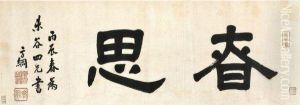Weng Fanggang Paintings
Weng Fanggang was a prominent Chinese scholar, calligrapher, painter, and epigrapher during the Qing Dynasty. Born on September 27, 1733, in Beijing, he was deeply influenced by the intellectual and artistic currents of his time. Weng came from a scholarly family and was recognized early on for his talents in classical literature and calligraphy. He passed the imperial examinations and held various official positions throughout his career, which allowed him to travel and study a wide array of subjects, including history, geography, and art.
Weng Fanggang was particularly renowned for his work in the field of epigraphy, the study of inscriptions. He had a profound interest in ancient scripts and stele inscriptions, and his research contributed significantly to the preservation and interpretation of ancient Chinese texts. He was a leading figure in the 'Jinshi' (金石学) school of thought, which advocated for the study of bronze and stone inscriptions as primary sources for understanding Chinese history and culture.
As a calligrapher, Weng Fanggang was skilled in various script styles, including standard script (楷书), running script (行书), and clerical script (隶书). His work was characterized by a deep understanding of traditional techniques combined with a personal flair that made his calligraphy highly sought after by collectors. His paintings, less well-known than his calligraphy, often reflected the same attention to detail and historical reverence.
Weng Fanggang's scholarly pursuits were not limited to the arts. He was also involved in the compilation and editing of several important literary and historical works. His dedication to the study of classical texts and his own writings on epigraphy had a lasting impact on later generations of scholars. Weng's erudition and artistic accomplishments made him one of the most respected intellectuals of the late Qing Dynasty.
He died on November 27, 1818, leaving behind a rich legacy in Chinese scholarship and art. Weng Fanggang's life and work reflect the broader intellectual and cultural milieu of Qing Dynasty China, where traditional learning was highly valued and where art and scholarship were often intertwined.

